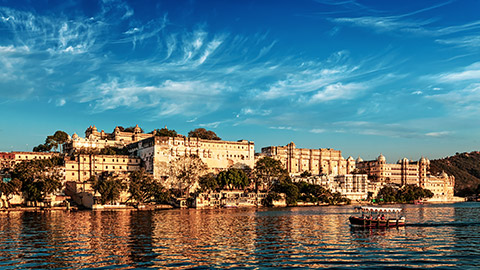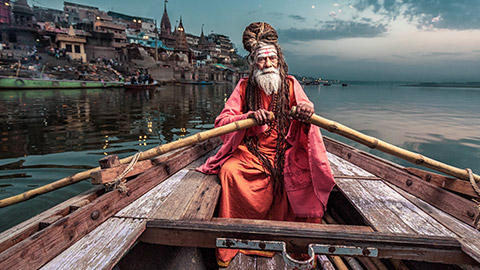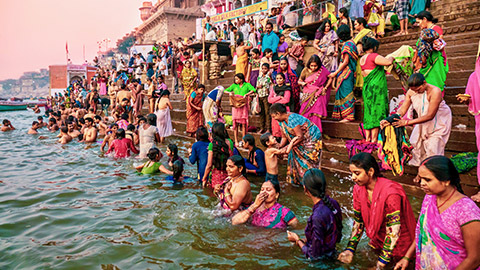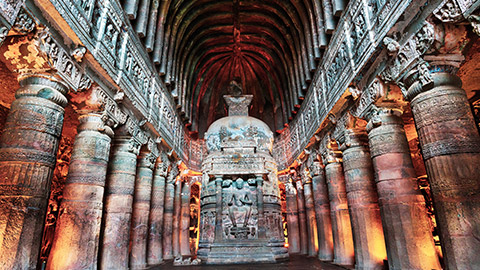The Bhagavad Gita- That Ancient Indian Yoga text- says that it is better to live your own destiny imperfectly than live an imitation of somebody else's life with perfection.Eat Pray Love
If you are seeking culture or an adventure for your senses, India's abundant tradition and lifestyle will more than meet your needs. Experience the relentless hustle and bustle of traffic, the vast array of colourful traditional dress and the heady aroma of spices. Combine it with the many amazing temples, festivals and natural wonders and you are in for an unforgettable experience!

India boasts many natural wonders, historical and architectural monuments, spiritual landmarks, arts and culture which are inspiring and refreshing for the soul. Many people come to India to explore various destinations and embark on a cultural and spiritual journey.
The cultural differences and huge population, however, make India a destination recommended for the experienced traveller only.
Discover palaces and places of worship in the 'pink city' of Jaipur. Many of these temples hold a long history of cultural significance and boasts stunning architecture that makes it a prominent part of India. The City Palace has a significant role in the Jaipur's history as it is the residence of the royal family.
Take in the beautiful view of the hills in the region of Darjeeling, which is world famous for its tea cultivation. The region produces about 10,000 tonnes of green, black, white and oolong tea every year.

Perhaps you would be interested in visiting the foothills of the Himalayas. Travel though the mountain tops on a tour train where you will be captivated by the natural beauty of the City Shimla.
Ancient, diverse, and exquisite, India is a sensory experience that can also be overwhelming.
From its rich culture, delicious food to its historic architecture and scenic outlooks, the country has something for every kind of traveller.
In case you need a bit of guidance figuring out what to do in the country, below is a list of places you can visit in India.

The History behind Taj Mahal
The Taj Mahal is a mausoleum (Large tomb) complex in Agra, western Uttar Pradesh state, northern India.
The name Taj Mahal when translated means "Crown Palace" or "Crown of the Palace."
The Taj Mahal was built by the emperor Shah Jahan, who had built the Taj Mahal in memory of his third wife Mumtaz Mahal, who died giving birth to their 14th child in 1631.
The Taj Mahal is arguably one of the most incredible man-made constructions in the world and became a world heritage site in 1983.
Other fun facts
- It is believed, at the time, to have cost 35 million rupees to build the Taj Mahal. (That would be about $725,000 NZD.)
- The Taj Mahal is built from precious white marble with delicate mosaic, with inlaid precious stones. Almost every surface of the entire building has been decorated.
To learn more about the Taj Mahal watch the following video.
Kaziranga National Park is a protected area in the northeast Indian state of Assam.
Spread across the floodplains of the Brahmaputra River, its forests, wetlands and grasslands are home to tigers, elephants and the world’s largest population of Indian one-horned rhinoceroses.
It is also home to Ganges River dolphins that swim in the park’s waters.
It’s visited by many rare migratory birds, and pelicans roost near Kaziranga village.

The lake Palace on Lake Pichola in the city of Udaipur, is a former summer palace of the royal dynasty of Mewar, built in the 18th century.
It is now a floating luxury 5-star hotel. The Lake Palace hotel operates a boat which transports guests to the hotel from a jetty at the City Palace on the east bank of Lake Pichola.
If you would like to know more information about the lake palace, you can watch the video below.

Allahabad and Varanasi are two very important pilgrimage sites in India with ancient civilisation from over 2000 years ago.
On this cruise you will see, experience and learn about the ancient history of the area whilst also experiencing the most colourful and interesting stretch of this legendary river – the River Ganges. Although these two cities are only 125kms apart by road, the winding river journey takes five days.
These tours have access to exclusive boats (with boatman) and a kitchen crew to prepare meals for the trip.
Overnight stays in exclusive islands are also part of this cruise. Hotels are usually the best way to spend the night, however if there is a small group of 10-15 then camping on a deserted beach or island may be offered.
You can expect to see many migratory birds and Ganges River dolphins along the way.

Upon reaching Varanasi, you will experience the holy site of the Ghats of Ganges (riverfront steps leading to the banks of the River Ganges). This is where pilgrims have been flocking for hundreds of years to take a dip in the sacred river Ganges.
Safaris are one of the most exciting parts of visiting a wildlife sanctuary or national park.
Another kind of safari is taking a ride on animals such as elephants or camels. It is a one-of-a-kind experience that must be tried at least once in your life.
Elephant safaris help the visitor to travel through difficult areas where even jeeps cannot venture.
Equipped with a howdah (a large seat that is placed on the elephant’s back that you sit on complete with soft silk cushions, and with a ceremonial umbrella over the rider’s head), you will see wild elephants taking a bath, while having the ability to get up close and personal with these amazing animals.
- Weather conditions can vary a lot, so you need to have a backup of water supplies, sun screen and a first aid kit.
- Clothing should be able to ‘breathe’
- Clothing should also be modest (not showing too much skin so you are culturally sensitive)
- Wearing some sort of head protection is advised.

The Ajanta Caves are a world heritage site located about 100 kms from Aurangabad. These rock-cut cave monuments date back to the 2nd century BC.
The city of Aurangabad is the gateway to the Ajanta Caves as well as the equally spectacular Ellora Caves.
These caves were excavated as a part of the first wave of cave architecture in India. It became an important part for Buddhist religion and art under the Vakataka rulers.
Ajanta Caves were abandoned from around 650 AD and found in 1819 when a British hunting party stumbled across them.
Many of the paintings still remain to this day, due to the preservation and isolation.
The well-preserved murals depict everything from battlefields to sailing ships, city streets and teeming animal-filled forests to snow-capped mountains.
The main theme of the carvings illustrate the events related to the life of Buddha. They also portray Buddhist philosophies and teachings of Buddha.
For more information, check out this website: touropia.com

The Harmandir Sahib, better known as the Golden Temple, is the main tourist attraction in Amritsar and the most important religious place to the Sikhs.
Construction of the Temple was begun by Guru Ramdas Ji in the 16th century.
Spiritually, the focus of attention is the tank that surrounds the gleaming central shrine. Ringed by a marble walkway, the tank is said to have healing powers, and pilgrims come from across the world to bathe in the sacred waters.
Floating at the end of a long causeway, the Golden Temple itself is a mesmerizing blend of Hindu and Islamic architectural styles, with an elegant marble lower level adorned with flower and animal motifs in pietra dura work (as seen on the Taj Mahal).
Floating around the Golden temple is a man-made Lake called the Amritsar, which means 'the lake of immortal nectar'. It is considered the gods home and whoever bathed in it would obtain spiritual and temporal advantages.
Above this rises a shimmering second level, encased in intricately engraved gold panels, and topped by a dome gilded with 750kg of gold.
It is a stunning temple, always full of thousands of visitors and pilgrims from all over India.
References
Tour my India (2020, April 27) India Travel and Tourism Blog
BBC News (2020, April 27) Why is Darjeeling Tea the fine wine of teas
History (2020, April 27) Taj Mahal
SP holidays (2020, April 28) Boat Tour on Ganges From Allahabad to Varanasi
The Guardian (2020, April 28) The Ajanta Cave murals: Nothing less than the birth of Indian Art
Lonely planet (2020, April 28) Golden Temple
